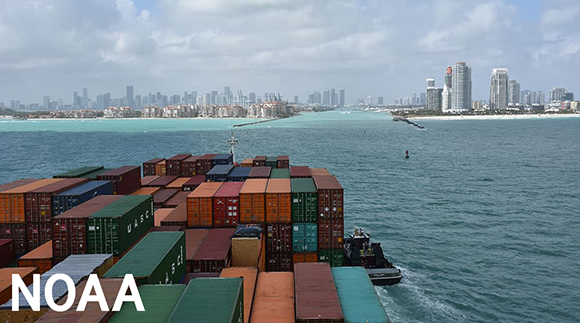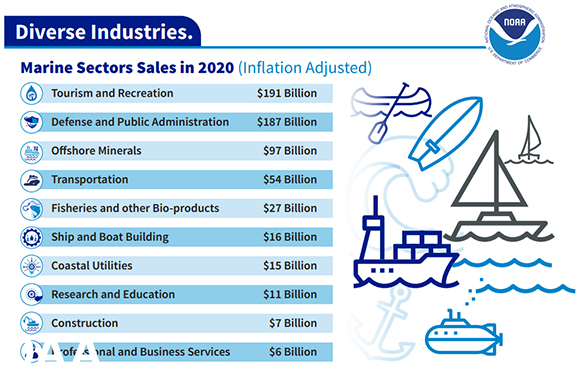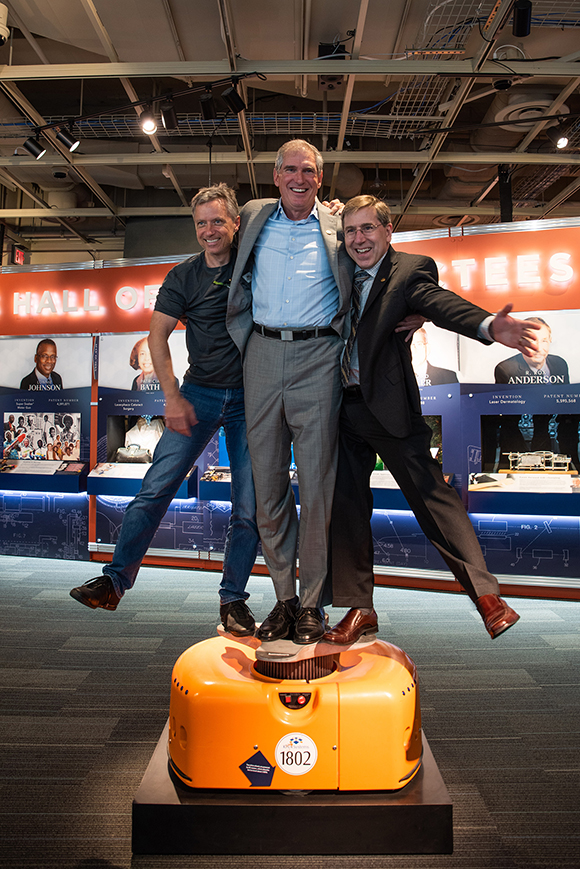|



|
FROM SITE SELECTION
MAGAZINE, MAY 2022 ISSUE
|

|
COLORADO
A packaged foods company leader who says he never lays in bed at night
and dreams about cooking chicken has left that world behind to become a
music and entertainment empresario in his hometown.
|
|

|
RESOURCE GUIDE
Find the names and websites of economic development organizations in
every state and a number of countries abroad.
|
|
|
CONWAY ANALYTICS
SNAPSHOT
|

|
A container ship enters the shipping channel at Port Miami.
Photo courtesy of NOAA
|
|
America’s marine economy contributed about $361 billion of the nation’s
gross domestic product in 2020 according to the annual Marine Economy Satellite Account report
released last week by two Department of Commerce agencies: NOAA and the
Bureau of Economic Analysis (BEA). That was a 5.8% or $23 billion
reduction from 2019’s contribution, due to the pandemic. But it’s still
a healthy chunk.
To get the statistics, experts from NOAA and BEA described 10 sectors
(see chart below) representing businesses dependent on the nation’s
ocean, coasts and Great Lakes between the years 2014 and 2020. The data,
report and other materials are available at NOAA’s Digital Coast website and on BEA Marine Economy website. Businesses included in the
report generated a total of $610 billion in sales and supported 2.2
million jobs in 2020. “Of particular note, the marine-based pharmacy
industry, one of the components of the Living Resources sector, had an
increase of almost 50% in sales, due to the approval of new marine-based
drugs for cancer treatment,” said NOAA Chief Economist Dr. Monica
Grasso. The report offers a bunch of tables breaking out the numbers by
industry but, oddly enough, doesn’t break down the data by geography.
We’re here to close the circle for you: A separate 2022 report from
NOAA’s Office of Coastal Management, housed within the National Ocean
Service, is called the “NOAA Report on the U.S. Marine Economy,” based
on 2019 data that first became available last summer. Beginning on page
11 of the 27-page report, the OCM’s breakdown by industry sector offers
at least some insight by sector. Some highlights:
- Marine Construction: From 2018 to 2019, employment
in this sector increased by 7.7%, while gross domestic product
increased by 4.2%.” At the state and local levels, trends are far
more erratic, spiking and rapidly declining as major harbor dredging
or beach renourishment projects are initiated,” the report states.
“Marine construction activities occur in most regions of the U.S.,
but are highly concentrated in Florida, Texas, California, and
Louisiana, which together in 2019 accounted for about 62% of the
employment and about 58.8% of the gross domestic product in this
sector.”
- Offshore Mineral
Extraction: In 2019, offshore mineral extraction
accounted for 3.4% of total employment in the marine economy and
contributed 25.5% of its GDP. “Average wages per employee of
$159,576 per year in this sector were almost three times the
national average,” the report says. “The national center of the oil
and gas industry is Texas. Harris County, Texas, alone accounted for
57.5% of the employment in the nation’s offshore mineral extraction
sector and 77% of its gross domestic product in 2019.”
- Ship and Boat Building:
“In 2019, Virginia contributed most to employment in this sector,
accounting for 24.6% of the national total. Washington State was the
largest contributor to gross domestic product in this sector,
accounting for 19.3% of the total. Kitsap County, Washington, was
the largest county in the nation’s ship and boat building sector; it
alone accounted for about 9.3% of the employment and 16.5% of the
gross domestic product in the nation’s ship and boat building
sector.”
- Marine Transportation:
This sector accounted for 16.6% of the employment and 19.8% of the
GDP in the U.S. marine economy. The sector paid one of the highest
average wages per employee, $67,968, in 2019. Warehousing is the
largest component of the marine transportation sector in terms of
employment, accounting for 57% of total employment for the sector.
To avoid overestimation, only warehousing activities located in
shore-adjacent counties are included in the data. “In the marine
transportation sector, about 20.5% of employment and 25.1% of real
gross domestic product are supported by California,” the report
says. “The rest is distributed across the nation, concentrated
around major seaports.”
- Tourism and Recreation:
From 2018 to 2019, tourism and recreation gained 31,759 jobs, which
was the second largest growth in absolute terms of any marine sector
after marine transportation. California and Florida are the two
largest contributors to this sector, together accounting for more
than one-third of the sector’s total employment and GDP in 2019.
— Adam Bruns
|

|
Infographic courtesy of NOAA
|
|
  |
|
SITE SELECTION
RECOMMENDS
|
As you likely know by now, those major seaports have been hot spots for the
global supply chain congestion that has seemingly plagued every industry.
But it’s about a lot more than supply and demand. If you’ve ever wondered
what “demurrage” really means to the overall logistics scene, and why it’s
playing its own part in literally holding things up, this in-depth report filed this morning by Michael
Grabell at ProPublica will open your eyes.
|
|
TEXAS ECONOMIC
DEVELOPMENT GUIDE 2022-2023
|

|
QUALITY OF LIFE
Five reasons life is larger in the Lone Star State.
|
|
  |
Bulgaria
Quick: Can you find Bulgaria on a world map? France’s Schneider Electric
sure can. The company originally opened its smart factory in Plovdiv in
2007, and last week announced this investment in order to boost
production of circuit breakers by 30%. The facility already produces 40
million annually. The 100 new jobs will bring headcount at the site to
over 1,000. As chronicled by Romanian publication Business Review last
summer, the Plovdiv factory is a regional pioneer in the digitization of manufacturing, located in what
many consider to be the oldest inhabited city in all of Europe.
Mexico
Varian, a Siemens Healthineers company, has joined the medical device
cluster in Baja California with this new site in Tijuana. “For us,
Tijuana is a key location that allows us to offer service to the North,
Central, and South American markets, since being located near the Palo
Alto, California factory and our U.S. distribution center, these
facilities become a strategic point that will allow us to create value
chains in healthcare equipment in Mexico,” said Humberto Izidoro,
Varian’s president for Latin America, in a YouTube video of the grand
opening ceremony posted by Co-Production International, which assisted
Varian with the establishment of the new operation under the IMMEX
Shelter Program. The facility aims to make approximately 550 linear
accelerators annually for radiotherapy equipment used in cancer
treatments.
|
|

|
Photo courtesy of the National Inventors
Hall of Fame Museum
|
|
Last month the National Inventors Hall of Fame Museum, located at the
headquarters of the U.S. Patent and Trademark Office in Alexandria,
Virginia, reopened to the public. Earlier in the month, 27 inventors were inducted, including Raffaello
D’Andrea, Mick Mountz, and Peter Wurman, shown here standing atop one of
the robot prototypes for their patented invention Mobile Robotic
Material Handling for Order Fulfillment called the Kiva system. Founded
in 2003 in the Boston area, Kiva Systems was purchased by Amazon in 2012
for $775 million. Things came full circle last fall when Amazon Robotics
opened a new 200-job manufacturing facility in Westborough,
Massachusetts, 50 miles from Kiva Systems’ original HQ in North Reading
(where Amazon Robotics still operates the site). Since introducing the
robots to its facilities in 2012, Amazon has deployed more than 350,000
drive units across its facilities.
|
|
|
|

